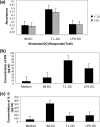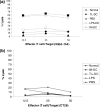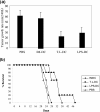Improvement of a dendritic cell-based therapeutic cancer vaccine with components of Toxoplasma gondii
- PMID: 19656994
- PMCID: PMC2756855
- DOI: 10.1128/CVI.00199-09
Improvement of a dendritic cell-based therapeutic cancer vaccine with components of Toxoplasma gondii
Abstract
The use of dendritic cells (DCs) as a cellular adjuvant is a promising approach to the immunotherapy of cancer. It has previously been demonstrated that DCs pulsed ex vivo with Toxoplasma gondii antigens trigger a systemic Th1-biased specific immune response and induce protective and specific antitoxoplasma immunity. In the present study, we demonstrate that tumor antigen-pulsed DCs matured in the presence of Toxoplasma gondii components induce a potent antitumor response in a mouse model of fibrosarcoma. Bone-marrow derived DCs (BMDCs) were cultured in the presence of granulocyte-macrophage colony-stimulating factor and interleukin-4. After 5 days, tumor lysates with or without the T. gondii lysate were added to the culture for another 2 days. The cytokine production in the BMDC culture and the coculture supernatants of DCs and splenic cells was evaluated. For immunization, 7 days after tumor challenge, different groups of BALB/c mice received different kinds of DCs subcutaneously around the tumor site. Tumor growth was monitored, and 2 weeks after DC immunotherapy, the cytotoxic activity and the infiltration of CD8(+) T cells were monitored in different groups. According to the findings, immunotherapy with T. gondii-matured DCs led to a significant increase in the activity of cytotoxic T cells and decreased the rate of growth of the tumor in immunized animals. Immature DCs did not cause any change in cytotoxic activity or the tumor growth rate compared to that in the healthy controls. The current study suggests that a specific antitumor immune response can be induced by DCs matured with T. gondii components and provide the basis for the use of T. gondii in DC-targeted clinical therapies.
Figures






Similar articles
-
Anti-tumor effects of Toxoplasma gondii and antigen-pulsed dendritic cells in mice bearing breast cancer.Parasites Hosts Dis. 2025 Feb;63(1):37-49. doi: 10.3347/PHD.24082. Epub 2025 Feb 25. Parasites Hosts Dis. 2025. PMID: 40045679 Free PMC article.
-
The boosting effect of co-transduction with cytokine genes on cancer vaccine therapy using genetically modified dendritic cells expressing tumor-associated antigen.Int J Oncol. 2006 Apr;28(4):947-53. Int J Oncol. 2006. PMID: 16525645
-
Listeria monocytogenes activated dendritic cell based vaccine for prevention of experimental tumor in mice.Iran J Immunol. 2008 Mar;5(1):36-44. Iran J Immunol. 2008. PMID: 18319523
-
Pulsing of dendritic cells with cell lysates from either B16 melanoma or MCA-106 fibrosarcoma yields equally effective vaccines against B16 tumors in mice.J Surg Oncol. 1998 Jun;68(2):79-91. doi: 10.1002/(sici)1096-9098(199806)68:2<79::aid-jso3>3.0.co;2-h. J Surg Oncol. 1998. PMID: 9624036 Review.
-
Dendritic cell gene therapy.Surg Oncol Clin N Am. 2002 Jul;11(3):645-60. doi: 10.1016/s1055-3207(02)00027-3. Surg Oncol Clin N Am. 2002. PMID: 12487060 Review.
Cited by
-
Immune-mediated regression of established B16F10 melanoma by intratumoral injection of attenuated Toxoplasma gondii protects against rechallenge.J Immunol. 2013 Jan 1;190(1):469-78. doi: 10.4049/jimmunol.1201209. Epub 2012 Dec 7. J Immunol. 2013. PMID: 23225891 Free PMC article.
-
Utilizing the nanosecond pulse technique to improve antigen intracellular delivery and presentation to treat tongue squamous cell carcinoma.Med Oral Patol Oral Cir Bucal. 2018 May 1;23(3):e344-e350. doi: 10.4317/medoral.22227. Med Oral Patol Oral Cir Bucal. 2018. PMID: 29680844 Free PMC article.
-
Parasites revive hope for cancer therapy.Eur J Med Res. 2024 Oct 5;29(1):489. doi: 10.1186/s40001-024-02057-2. Eur J Med Res. 2024. PMID: 39367471 Free PMC article. Review.
-
Toxoplasma gondii infection possibly reverses host immunosuppression to restrain tumor growth.Front Cell Infect Microbiol. 2022 Aug 31;12:959300. doi: 10.3389/fcimb.2022.959300. eCollection 2022. Front Cell Infect Microbiol. 2022. PMID: 36118042 Free PMC article. Review.
-
Mining parasites for their potential as novel therapeutic agents against cancer.Med Oncol. 2024 Jul 29;41(9):211. doi: 10.1007/s12032-024-02458-7. Med Oncol. 2024. PMID: 39073638 Review.
References
-
- Akira, S. 2003. Mammalian Toll-like receptors. Curr. Opin. Immunol. 15:5-11. (Erratum, 15:238.) - PubMed
-
- Aosai, F., M. S. Rodriguez Pena, H. S. Mun, H. Fang, T. Mitsunaga, K. Norose, H. K. Kang, Y.-S. Bae, and A. Yano. 2006. Toxoplasma gondii-derived heat shock protein 70 stimulates maturation of murine bone marrow-derived dendritic cells via Toll-like receptor 4. Cell Stress Chaperones 11:13-22. - PMC - PubMed
-
- Banchereau, J., F. Briere, C. Caux, J. Davoust, S. Lebecque, Y. J. Liu, B. Pulendran, and K. Palucka. 2000. Immunobiology of dendritic cells. Annu. Rev. Immunol. 18:767-811. - PubMed
-
- Banchereau, J., and R. M. Steinman. 1998. Dendritic cells and the control of immunity. Nature 392:245-252. - PubMed
-
- Barton, G. M., and R. Medzhitov. 2002. Control of adaptive immune responses by Toll-like receptors. Curr. Opin. Immunol. 14:380-383. - PubMed
Publication types
MeSH terms
Substances
LinkOut - more resources
Full Text Sources
Other Literature Sources
Research Materials

